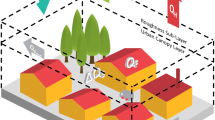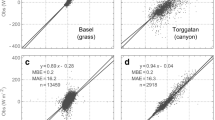Abstract
This paper addresses the relation between the net-radiation (Q *) and the ground heat flux (Q G), the energy stored in the soil (\(\Updelta Q_{\rm S}\)), and the residual of the energy partition (R = Q * − Q H − Q E ) of urban and suburban areas of Oklahoma City, USA. These three forms of energy were observed or estimated from observations taken during Joint Urban 2003 Campaign. The database includes net-radiation, soil temperature, ground heat flux, and turbulent fluxes. In most cases the estimates of the energy stored in the soil were obtained by assuming roughly a certain type of soil and an effective soil depth. From the residuals it seems to be possible to distinguish the urban boundary layer from the suburban boundary layer when plotted as a function of net-radiation. Hysteresis coefficients were computed for fits of net-radiation against R, \(\Updelta Q_{\rm S}\) and Q G. In particular, the hysteresis patterns show that Q * vs. R represents clearer urban areas or suburban areas under the influence of an urban “plume”. On the other hand, hysteresis curves obtained from \(\Updelta Q_{\rm S}\) or Q G account for better the ground composition. A possible consequence is that the land use of urban areas could be roughly inferred from curve shapes such as Q * vs. R, or Q * versus another input variable representing the storage term. The objective is to show the variability of the subsurface-related energy fluxes across an urban area using these three different quantities and also to show that \(\Updelta Q_{\rm S}, \,Q_{\rm G}\), or R (and their corresponding hysteresis curves) are likely to be quantitatively different, which have not been clearly stated in the literature.









Similar content being viewed by others
References
Allwine KJ, Leach MJ, Stockham LW, Shinn JS, Hosker RP, Bowers JF, Pace JC (2004) Overview of Joint Urban 2003—an atmospheric dispersion study in Oklahoma City. In: Proceedings of the 84th AMS annual meeting, Seattle, USA
Allwine KJ, Flaherty JE (2006) Joint Urban 2003: study overview and Instrument Locations, PNNL Report.
Allwine KJ, Leach M (2007) Editorial. J Appl Meteorol Climatol 46:2017–2018
Anandakumar K (1999) A study on the partition of net radiation into heat fluxes on a dry asphalt surface. Atmos Environ 33:3911–3918
Asaeda T, Ca VT, Wake A (1996) Heat storage of pavement and its effect on the lower atmosphere. Atmos Environ 30:413–427
Aubinet M, Vesala T, Papale D (2012) Eddy covariance—a practical guide to measurement and data analysis. Springer, Dordrecht
Balogun AA, Adegoke JO, Vezhapparambu S, Mauder M, McFadden JP (2009) Surface energy balance measurements above an exurban residential neighbourhood of Kansas City, Missouri. Bound Layer Meteorol 133:299–321
Basara JB, Hall Jr PK, Schroeder AJ, Illston BG, Nemunaitis KL (2008) Diurnal cycle of the Oklahoma City urban heat island. J Geophys Res 113:D20109
Brotzge JA, Weber D (2002) Land-surface scheme validation using the Oklahoma Atmospheric Surface-layer Instrumentation System (OASIS) and Oklahoma Mesonet data: preliminary results. Meteorol Atmos Phys 80:189–206
Camuffo D, Bemardi A (1982) An observational study of heat fluxes and the relationship with net radiation. Bound Layer Meteorol 23:359–368
Cheng H, Castro IP (2002) Near-wall flow development after a step change in surface roughness. Bound Layer Meteorol 105:411–432
Fuchs M, Hadas A (1972) The heat flux density in a non-homogeneous bare loessial soil. Bound Layer Meteorol 3:191–200
Foken T (2008) The energy balance closure problem: an overview. Ecol Appl 18:1351–1367
Garratt JR (1994) The atmospheric boundary layer. Cambridge, New York
Gouveia, FJ, Leach MJ, Shinn JH (2004) Measurements of net radiation, ground heat flux and surface temperature in an urban canyon. In: Proceedings of the 84th AMS annual meeting, Seattle, Paper J7.4
Grimmond CSB, Oke TR (1999) Heat Storage in urban areas: local-scale observations and evaluation of a simple model. J Appl Meteorol 38:922–940
Grimmond CSB, Su HB, Offerle B, Crawford B, Scott S, Zhong S, Clements C (2004) Variability of sensible heat fluxes in a suburban area of Oklahoma city. In: Proceedings of the 84th AMS annual meeting, Seattle, USA.
Hanna SR, Chang JC (1992) Boundary layer parameterizations for applied dispersion modeling over urban areas.. Bound Layer Meteorol 58:229–259
Hanna SR, Marciotto ER, Britter RE (2011) Urban energy fluxes in built-up downtown areas and variations across the urban area, for use in dispersion models. J Appl Meteorol Climatol 50:1341–1353
Holeman JE, Princevac M, Grossman-Clarke S, Lee SM, Fernando HJS, Calhoun R (2004) Joint Urban 2003 surface energy budget measurements and analysis. In: XXI ICTAM, 1521 August 2004, Warsaw, Poland
Lemonsu A, Grimmond CSB, Masson V (2004) Modeling the surface energy balance of the core of an old Mediterranean City: Marseille. J Appl Meteorol 43:312–327
Marciotto ER, Oliveira AP, Hanna SR (2010) Modeling study of the aspect ratio influence on urban canopy energy fluxes with a modified wall canyon energy budget scheme. Build Environ 45:2497–2505
Meyn SK (2000) Heat fluxes through roofs and their relevance to estimates of urban heat storage. Thesis, University of British Columbia
Meyn SK, Oke TR (2009) Heat fluxes through roofs and their relevance to estimates of urban heat storage. Build Environ 41:745–752
Offerle B, Grimmond CSB, Fortuniak K (2005) Heat storage and anthropogenic heat flux in relation to the energy balance of a central European city centre. Int J Climatol 25:405–1419
Oke TR (1981) Canyon geometry and the nocturnal urban heat island: Comparison of scale model and field observations. J Climatol 1:237–254
Oke TR (1987) Boundary Layer Climates. Routledge, London.
Oke TR (2006) Initial guidance to obtain representative meteorological observations at urban sites, WMO/TD-No. 1250
Oke TR, Cleugh HA (1987) Urban heat storage derived as energy balance residuals. Bound Layer Meteorol 39:233–245
Pearlmutter D, Berliner P, Shaviv E (2005) Evaluation of urban surface energy fluxes using an open-air scale model. J Appl Meteorol 44:532–545
Pearlmutter D, Kruger EL, Berliner P (2008) The role of evaporation in the energy balance of an open-air scaled urban surface. Int J Climatol 29:911–920
Ramamurthy P, Pardyjak ER, Klewicki JC (2007) Observations of the effect of atmospheric stability on turbulence statistics deep within an urban street canyon. J Appl Meteorol 46:2074–2085
Roberts SM, Oke TR, Grimmond CSB, Voogt JA (2006) Comparison of four methods to estimate urban heat storage. J Appl Meteorol 45:1766–1780
Roth M (2007) Review of urban climate research in (sub)tropical regions. Int J Climatol 27:1859–1873
Acknowledgments
The author thanks reviewers for many valuable comments and also acknowledges the Fundação de Amparo à Pesquisa do Estado de São Paulo (FAPESP) under Grant 2010/16510-0 for the financial support.
Author information
Authors and Affiliations
Corresponding author
Additional information
Responsible editor: R. Roebeling.
Rights and permissions
About this article
Cite this article
Marciotto, E.R. Variability of energy fluxes in relation to the net-radiation of urban and suburban areas: a case study. Meteorol Atmos Phys 121, 17–28 (2013). https://doi.org/10.1007/s00703-013-0253-9
Received:
Accepted:
Published:
Issue Date:
DOI: https://doi.org/10.1007/s00703-013-0253-9




